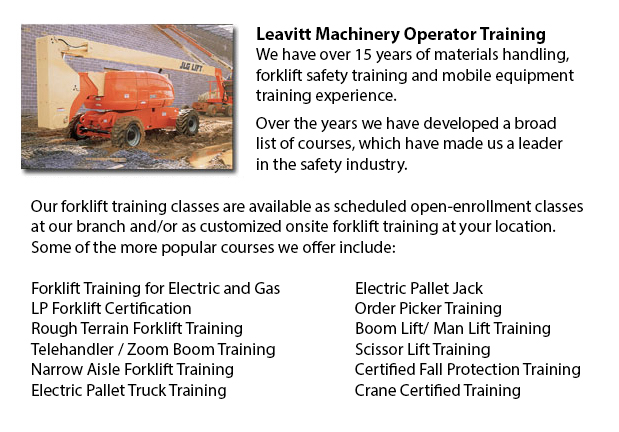
Aerial Lift Safety Training Kelowna - There are about 26 to 30 construction fatalities in North America due to the utilization of aerial lifts. Most of the individuals killed are craftsmen like laborers, painters, electrical workers, ironworkers or carpenters. Nearly all deaths are caused by tip-overs, electrocutions and falls. The greatest hazard is from boom-supported lifts, such as bucket trucks and cherry pickers. Nearly all fatalities are related to this particular type of lift, with the rest involving scissor lifts. Other dangers include being thrown out of a bucket, being struck by falling objects, and being caught between the lift bucket or guardrail and a thing, like a joist or steel beam.
To operate an aerial lift safely, perform an inspection on the following things before using the device: emergency and operating controls, safety devices (such as, guardrails and outriggers), personal fall protection gear, and tires and wheels. Inspect for possible leaks in the air, fuel-system, hydraulic fluid. Check the device for loose or missing components.
The places that worker would utilize the aerial device should be inspected carefully for potential dangers, like for example holes, bumps, drop-offs and debris. Overhead powerlines need to be monitored and avoided. It is recommended that aerial lift devices be utilized on level, stable surfaces. Don't work on steep slopes which go beyond slope restrictions specified by the manufacturer. Even on a level slope, wheel chocks, outriggers and brakes should be set.
Employers are required to provide maintenance mechanics and aerial lift operators with the proper manuals. Operators and mechanics should be trained by a certified person experienced with the relevant aerial lift model.
Aerial Lift Safety Tips:
o Close lift platform chains or doors prior to operating.
o Do not lean over or climb on guardrails. Stand on the platform or floor of the bucket.
o Make use of the provided manufacturer's load-capacity limits.
o Use work-zone warnings, such as cones and signs, when working near traffic.
If right procedures are followed, electrocutions are avoidable. Stay at least 10 feet away from whatever power lines and qualified electricians should de-energize and/or insulate power lines. Those working should use personal protective equipment and tools, like for example a bucket that is insulated. Nevertheless, a bucket which is insulated does not protect from electrocution if, for instance, the individual working touches a different wire providing a path to the ground.
When within the bucket, workers must prevent possible falls by securing themselves to the guardrails by using a positioning device or a full-body harness. If there is an anchorage within the bucket, a positioning belt along with a short lanyard is acceptable.
Tip-overs are avoidable by following the manufacturer's instructions. Unless otherwise specified by the manufacturer, never drive whilst the lift platform is elevated. Adhere to the vertical and horizontal reach restrictions of the device, and never exceed the specified load-capacity.
-
Counterbalance Forklift License Kelowna
Counterbalance Forklift License Kelowna - Forklifts, when operated by completely trained workers, are a major advantage to companies. We offer a thorough training program consisting of all parts of operating a powered lift device. Counterbalance fork... More -
Forklift Certification Schools Kelowna
Forklift Certification Schools Kelowna - Within North America, forklift certification is mandatory, making forklift training programs important for both the company and their employees working as forklift operators. Forklift training focuses on healt... More -
Manlift Operator Certification Kelowna
Manlift Operator Certification Kelowna - We provide a scissor platform and aerial lift training and certification to empower the trainee with the general understanding and knowledge of the safe and efficient utilization of "Power Operated Mobile Work... More -
Crane Training Schools Kelowna
Crane Training Schools Kelowna - We have designed several programs for Mobile Crane Operation at our Crane Training Schools. These programs are recommended for the experienced operator who requires re-certification or certification, and for inexperie... More -
Heavy Equipment Operator Classes Kelowna
Heavy Equipment Operator Classes Kelowna - A heavy equipment operator is a person who has received the proper training to operate a particular type or piece of machine. There are a lot of ways for the operator to undergo training and certification in... More -
Telehandler, Rotational Telehandler, Zoom Boom Training in Kelowna
Telehandlers or also known as Telescopic handlers are really popular piece of heavy construction equipment normally utilized in agriculture and construction trades. These equipments have extreme reaching capability and could get to places where a tra... More -
Zoom Boom Training Kelowna
Zoom Boom Training Kelowna - Zoom Boom Training is intended to train operators on variable reach forklifts. The goals of the training are to impart an understanding of the physics of the equipment, and to outline the operator's tasks. This course fol... More -
Boom Lift Safety Training Kelowna
Boom Lift Safey Training Kelowna - Boom lifts fall under the type of elevated work platform or aerial lifting device. Most normally utilized in construction, industry, and warehousing; the boom lift is so versatile that it can be utilized in almost w... More

Forklift Training Kelowna
TOLL FREE: 1-888-254-6157
Kelowna, British Columbia
forklifttraininginkelowna.com
Email Us
About Us


